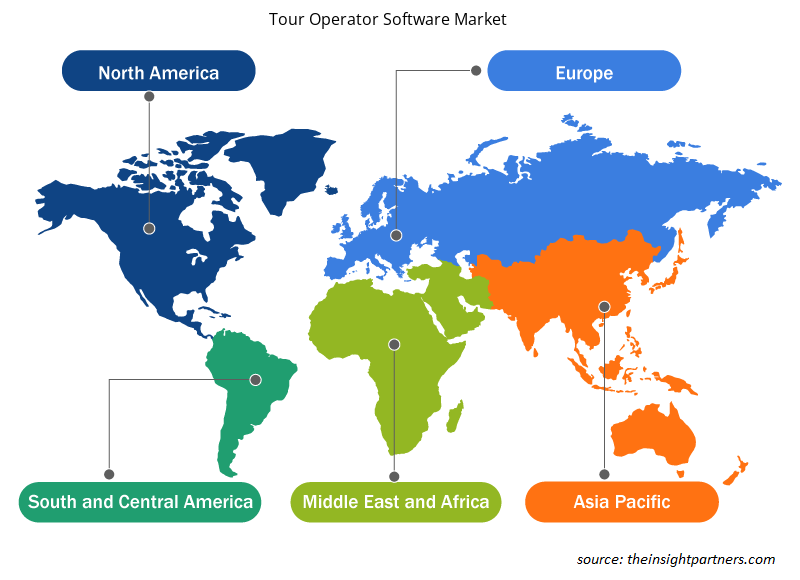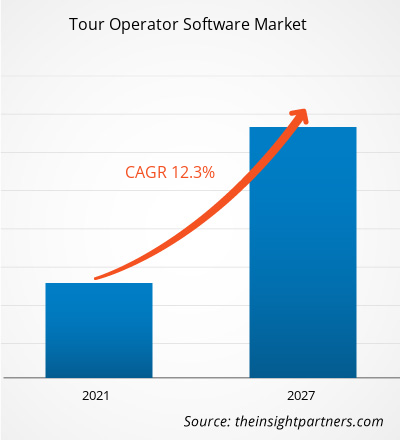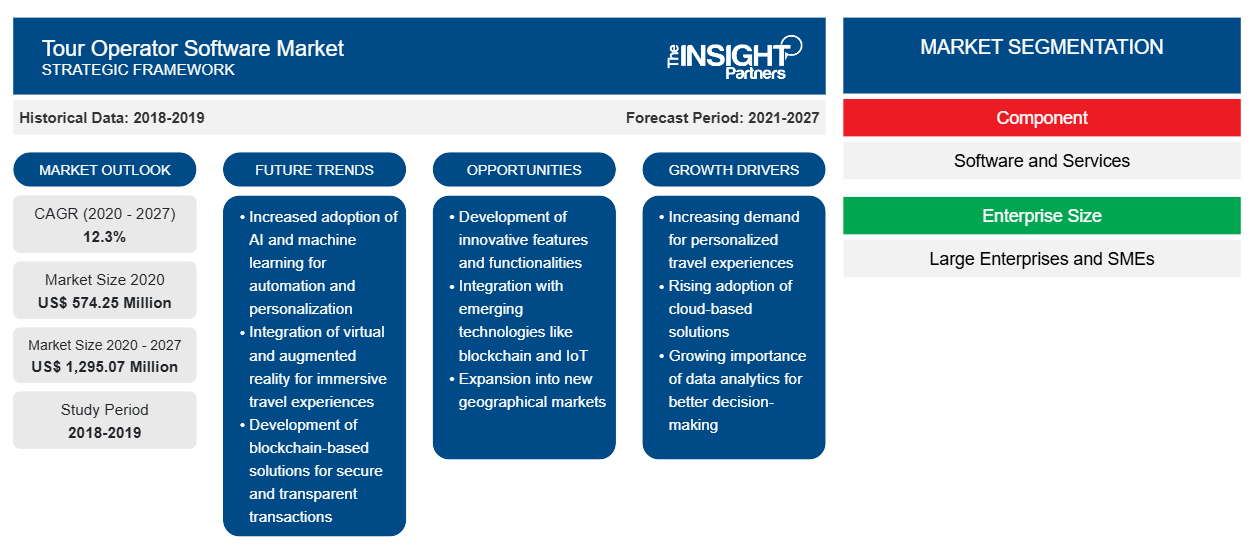Se espera que el mercado de software para operadores turísticos crezca de US$ 574,25 millones en 2020 a US$ 1295,07 millones en 2027; se estima que crecerá a una CAGR del 12,3% entre 2020 y 2027.
El crecimiento de la industria del turismo a nivel mundial, con unas perspectivas económicas positivas, se debe al crecimiento del mercado. El crecimiento del sector turístico está influenciado por factores como el crecimiento del PIB, el tamaño de la economía, el desarrollo de la infraestructura de viajes, la combinación de industrias, la población y las políticas regulatorias. Estos factores varían de un país a otro y afectan a la inversión en viajes en ese país en particular. La industria del turismo ha experimentado un impulso estupendo a lo largo de los años y está en constante aumento. La demanda de turismo entre todas las clases sociales ha llevado al surgimiento de varios tipos de turismo, como el turismo por carretera, el turismo fluvial y el turismo aéreo, entre los cuales el turismo por carretera ha dominado la industria durante un largo período. El aumento de los ingresos disponibles entre las masas de los países desarrollados y en desarrollo ha dado lugar a una creciente adopción de los operadores turísticos para reservar sus viajes optando por ofertas fascinantes. Además, se espera que el crecimiento del PIB en países en desarrollo como China e India ofrezca amplias oportunidades para el crecimiento del mercado en los próximos años. Con unas perspectivas económicas globales positivas, inversiones en infraestructuras de viajes, crecimiento de las PYME, enormes volúmenes de comercio transfronterizo y condiciones políticas que se estabilizan, se espera que el gasto en turismo aumente en los próximos años en todo el mundo. Con la creciente globalización y el comercio transfronterizo, el gasto en turismo también está aumentando. Estos factores han tenido un impacto positivo en el crecimiento del mercado de software para operadores turísticos.
Personalice este informe según sus necesidades
Obtendrá personalización en cualquier informe, sin cargo, incluidas partes de este informe o análisis a nivel de país, paquete de datos de Excel, así como también grandes ofertas y descuentos para empresas emergentes y universidades.
-
Obtenga las principales tendencias clave del mercado de este informe.Esta muestra GRATUITA incluirá análisis de datos, desde tendencias del mercado hasta estimaciones y pronósticos.
Impacto de la pandemia de COVID-19 en el mercado de software para operadores turísticos
La aparición y rápida propagación del coronavirus (COVID-19) ha paralizado a numerosos países, tanto desarrollados como en desarrollo. El aumento continuo en el recuento de pacientes infectados está amenazando a varias industrias en todo el mundo. A diciembre de 2020, Estados Unidos, India, Brasil, Rusia y Francia, son algunos de los países más afectados en términos de casos confirmados y muertes reportadas. El brote de coronavirus ha estado afectando a las economías e industrias en varios países debido a bloqueos, prohibiciones de viaje y cierres comerciales. Dado que la mayoría de los países están ejerciendo bloqueos, lo que resultó en el impacto negativo en el sector de viajes y turismo. Las restricciones temporales a los viajes nacionales e internacionales por parte del gobierno de diferentes regiones, también están mostrando una tendencia negativa en el sector turístico. La continuidad de la propagación de COVID-19, sería extremadamente peligrosa para los actores del mercado de software de operadores turísticos .
Perspectivas de mercado: mercado de software para operadores turísticos
Aumento de la adopción de IA en el sector turístico
La creciente integración de la inteligencia artificial (IA) para la mejora del proceso general de reserva de paquetes turísticos atractivos a través de los operadores, lo que está impulsando la adopción de software para operadores turísticos. La adopción de la IA y la robótica en la industria del turismo está impulsando la experiencia del cliente y los servicios ofrecidos por el operador turístico. Con la introducción de la inteligencia artificial de viajes, los planes de viaje para el pasajero se mejoran aún más para cumplir con sus expectativas. También ofrece servicios de viaje superiores, que son personalizados, automatizados y reveladores. La integración de la IA permite a los operadores turísticos estudiar los intereses y comportamientos de los viajeros y ofrecer una experiencia mejorada. La IA en la industria de viajes y turismo se centra principalmente en la participación y el servicio al cliente, para impulsar aún más la experiencia de viaje de los viajeros. Las tecnologías de IA emergentes, como los chatbots, los traductores de idiomas y la realidad virtual en los sectores del turismo, están impactando positivamente en la industria de viajes, turismo y hospitalidad. Por lo tanto, la creciente integración de la IA está impulsando aún más el sector del turismo en todo el mundo.
Información basada en componentes
Según los componentes, el mercado de software para operadores turísticos se segmenta en software y servicios. El segmento de software tuvo la mayor participación de mercado en 2019.
Los actores que operan en el mercado de software para operadores turísticos se centran principalmente en el desarrollo de productos avanzados y eficientes.
- En 2020, GP Solutions GmbH y ComBtas establecieron una asociación estratégica. Esta alianza está destinada a los clientes presentes en el mercado israelí. Con esta colaboración, ComBtas promoverá los productos llave en mano de GP Solutions, incluidos GP Travel Enterprise y GP Travel Hub.
- En 2020, Travefy, Inc. lanzó un creador de sitios web para asesores de viajes. El creador de sitios web permite a los asesores crear sitios web o una página de destino de marketing. El creador de sitios web utiliza una interfaz de arrastrar y soltar, y los asesores pueden elegir un tema, personalizar el contenido y se pueden utilizar URL personalizadas. Además, la herramienta está incluida en el plan de suscripción.
Perspectivas regionales del mercado de software para operadores turísticos
Los analistas de Insight Partners explicaron en detalle las tendencias y los factores regionales que influyen en el mercado de software para operadores turísticos durante el período de pronóstico. Esta sección también analiza los segmentos y la geografía del mercado de software para operadores turísticos en América del Norte, Europa, Asia Pacífico, Oriente Medio y África, y América del Sur y Central.

- Obtenga datos regionales específicos para el mercado de software para operadores turísticos
Alcance del informe sobre el mercado de software para operadores turísticos
| Atributo del informe | Detalles |
|---|---|
| Tamaño del mercado en 2020 | US$ 574,25 millones |
| Tamaño del mercado en 2027 | US$ 1.295,07 millones |
| Tasa de crecimiento anual compuesta (CAGR) global (2020-2027) | 12,3% |
| Datos históricos | 2018-2019 |
| Período de pronóstico | 2021-2027 |
| Segmentos cubiertos |
Por componente
|
| Regiones y países cubiertos |
América del norte
|
| Líderes del mercado y perfiles de empresas clave |
|
Densidad de actores del mercado de software para operadores turísticos: comprensión de su impacto en la dinámica empresarial
El mercado de software para operadores turísticos está creciendo rápidamente, impulsado por la creciente demanda de los usuarios finales debido a factores como la evolución de las preferencias de los consumidores, los avances tecnológicos y una mayor conciencia de los beneficios del producto. A medida que aumenta la demanda, las empresas amplían sus ofertas, innovan para satisfacer las necesidades de los consumidores y aprovechan las tendencias emergentes, lo que impulsa aún más el crecimiento del mercado.
La densidad de actores del mercado se refiere a la distribución de las empresas o firmas que operan dentro de un mercado o industria en particular. Indica cuántos competidores (actores del mercado) están presentes en un espacio de mercado determinado en relación con su tamaño o valor total de mercado.
Las principales empresas que operan en el mercado de software para operadores turísticos son:
- Checkfront Inc
- Soluciones GP GmbH
- Rezdy
- Plan de viaje
- Travefy, Inc.
Descargo de responsabilidad : Las empresas enumeradas anteriormente no están clasificadas en ningún orden particular.

- Obtenga una descripción general de los principales actores clave del mercado de software para operadores turísticos
El mercado de software para operadores turísticos se ha segmentado de la siguiente manera:
Mercado mundial de software para operadores turísticos: por componente
- Software
- Servicios
Mercado mundial de software para operadores turísticos: por tamaño de empresa
- Grandes empresas
- PYMES
Mercado mundial de software para operadores turísticos: por tipo de suscripción
- Suscripción única
- Suscripción mensual
- Suscripción anual
Mercado mundial de software para operadores turísticos, por geografía
-
América del norte
- A NOSOTROS
- Canadá
- México
-
Europa
- Francia
- Alemania
- Italia
- Rusia
- Reino Unido
- Resto de Europa
-
Asia Pacífico (APAC)
- Japón
- Porcelana
- Australia
- India
- Corea del Sur
- Resto de APAC
-
Oriente Medio y África (MEA)
- Arabia Saudita
- Emiratos Árabes Unidos
- Sudáfrica
- Resto de MEA
-
América del Sur (SAM)
- Brasil
- Argentina
- Resto de SAM
Mercado de software para operadores turísticos: perfiles de empresas
- Checkfront Inc
- Soluciones GP GmbH
- Rezdy
- Plan de viaje
- Travefy, Inc.
- Travelo Pro
- Tecnologías Trawex Pvt Ltd.
- TrekkSoft (Grupo TrekkSoft)
- TRYTN, Inc.
- Xola, Inc.
- Análisis histórico (2 años), año base, pronóstico (7 años) con CAGR
- Análisis PEST y FODA
- Tamaño del mercado, valor/volumen: global, regional y nacional
- Industria y panorama competitivo
- Conjunto de datos de Excel
Informes recientes
Informes relacionados
Testimonios
Razón para comprar
- Toma de decisiones informada
- Comprensión de la dinámica del mercado
- Análisis competitivo
- Información sobre clientes
- Pronósticos del mercado
- Mitigación de riesgos
- Planificación estratégica
- Justificación de la inversión
- Identificación de mercados emergentes
- Mejora de las estrategias de marketing
- Impulso de la eficiencia operativa
- Alineación con las tendencias regulatorias























 Obtenga una muestra gratuita para - Mercado de software para operadores turísticos
Obtenga una muestra gratuita para - Mercado de software para operadores turísticos